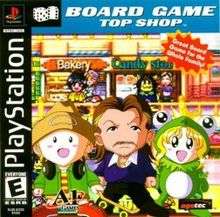Top Shop
Board Game Top Shop,[5] known in Japan as Tenant Wars (テナントウォーズ)(Tenantouŏ̄zu),[4] is a video board game developed by KID for the PlayStation and Sega Saturn. Although both releases were published in Japan, only the PlayStation version was issued in North America where it was given an "E" rating by the ESRB.[5]
| Top Shop | |
|---|---|
 North American cover art. | |
| Developer(s) | KID |
| Publisher(s) | PlayStation KIDJP (1998) SuccessJP (1999) AgetecNA Sega Saturn KIDJP |
| Series | A1 GamesNA SuperLite 1500JP |
| Platform(s) | •PlayStation •Sega Saturn |
| Release | |
| Genre(s) | Board game |
| Mode(s) | •Single-player •Multiplayer (up to 6 Players) |
Gameplay
The gameplay of Top Shop mimics that of Monopoly,[3] but expands on the property management aspect of that game. As in Monopoly, players move across a game board in accordance to the number they roll on a die, purchase unowned properties when they land on such and earn money when they reach the bank. Rolling an "E" triggers a random event,[3] while landing on an elevator space can affect the direction in which the player moves.
Top Shop deviates from Monopoly when players land on spaces owned by other players. Instead of paying rent, the landing-player must buy an item from the owner-player's store. Items cost varying levels of money, and when one buys them they disappear from the store and must be restocked by the owner. In addition, when an item is bought the buyer may receive "cash back"[3] and/or a random number of points which can be used at the bank to buy various special events, such as "Random Money Exchange" or "Win the Game." When neighboring spaces are purchased by the same player, a larger shop with greater stock capacity and more available expensive items is built.[3] Stores themselves can only be bought from other players when they are sold out of all their goods and can only be restocked by their owners when they land on the store, unless a special event allows otherwise.
In addition to multitap support, Top Shop features eight maps, eleven characters, and forty-four shops.[3] It can be played in either story or free play mode.
Reception
Weekly Famitsu scored the PlayStation version at 25 out of 40, citing the games' simplicity as both a benefit and detractor.[6]
References
- テナントウォーズ (in Japanese). Sony Computer Entertainment Inc. Archived from the original on April 25, 2013. Retrieved April 25, 2013.
- "Board Game - Top Shop". Agetec Inc. Archived from the original on April 25, 2013. Retrieved April 2, 2013.
- "SuperLite 1500 シリーズ「テナントウォーズα」" (in Japanese). Success Corporation. Archived from the original on January 16, 2000. Retrieved April 25, 2013.
- [セガハード大百科] セガサターン対応ソフトウェア(ライセンシー発売) (in Japanese). Sega Corporation. Archived from the original on March 12, 2009. Retrieved April 25, 2013.
- "Board Game Top Shop". Entertainment Software Rating Board. Retrieved April 2, 2013.
- "テナントウォーズ [PS] / ファミ通.com" (in Japanese). Enterbrain, Inc. Archived from the original on April 25, 2013. Retrieved April 25, 2013.